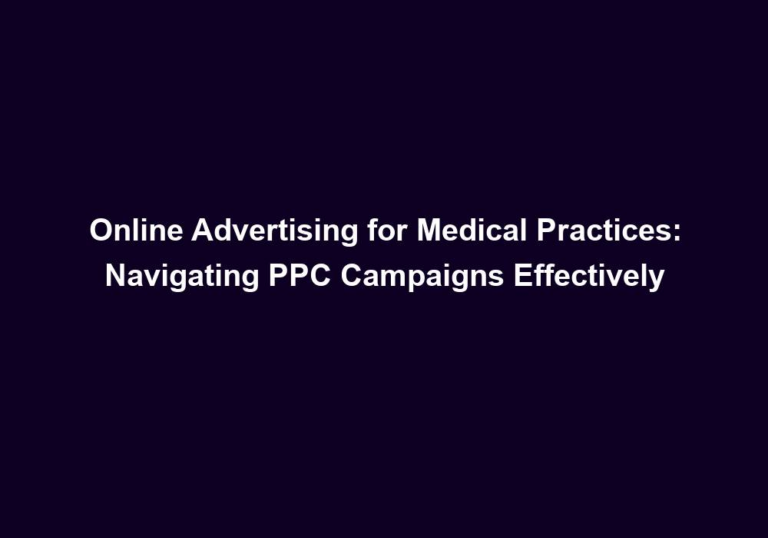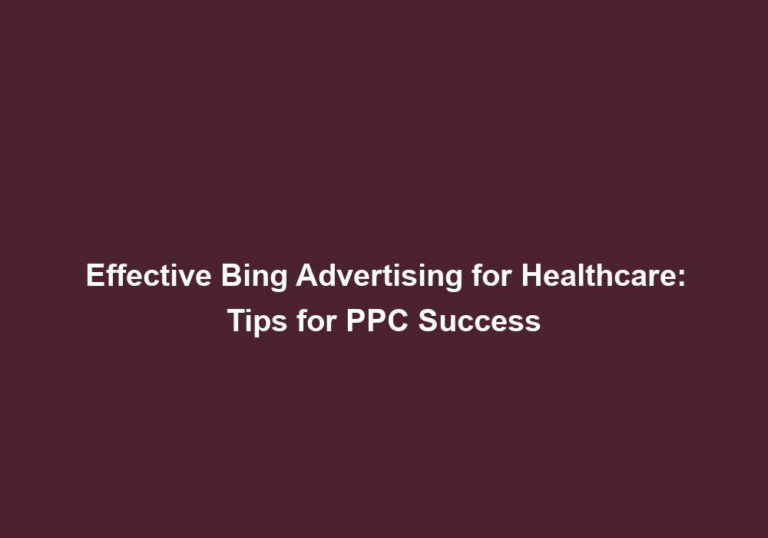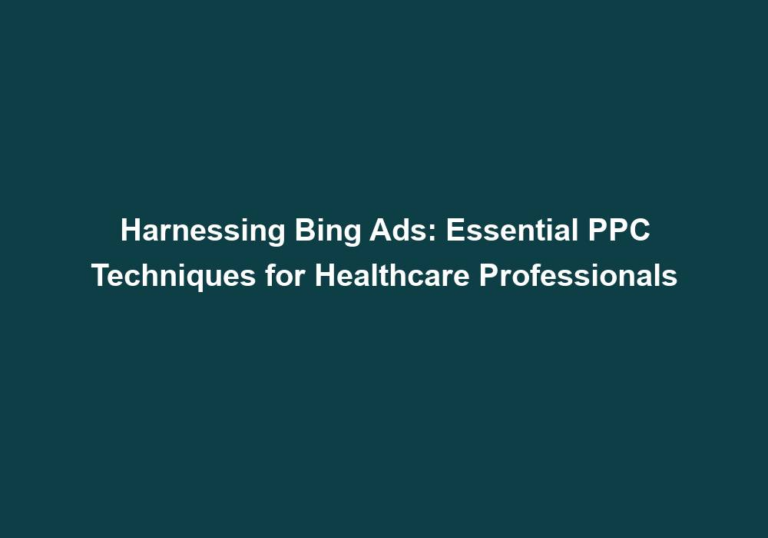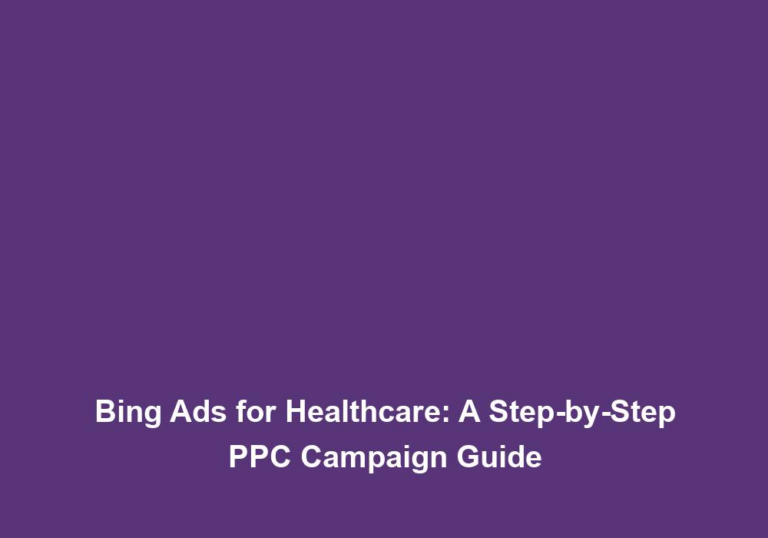Driving Patient Engagement: Google Ads Strategies for Healthcare PPC
In today’s digital world, healthcare providers must effectively engage with patients and drive traffic to their websites. Google Ads is a powerful tool that can help achieve this goal. With its wide reach and targeting capabilities, Google Ads can be a game-changer for healthcare PPC (Pay-Per-Click) campaigns. In this article, we will explore some effective strategies to maximize patient engagement through Google Ads.
1. Understanding Your Target Audience
Before diving into Google Ads, it is essential to have a deep understanding of your target audience. By researching and analyzing your patients’ demographics, interests, and online behavior, you can create highly targeted ads that resonate with your audience and increase engagement.
- Conduct surveys or analyze patient data to gather information on demographics such as age, gender, and location.
- Use tools like Google Analytics to track user behavior on your website and identify patterns.
- Research online forums, social media, and healthcare websites to understand your audience’s interests and preferences.
By understanding your target audience, you can tailor your Google Ads campaigns to meet their specific needs and preferences.
2. Utilize Relevant Keywords
Keywords play a crucial role in driving traffic to your website through Google Ads. Conduct thorough keyword research to identify the most relevant and frequently searched terms in the healthcare industry.
- Use tools like Google Keyword Planner or SEMrush to discover keywords with high search volume and low competition.
- Consider long-tail keywords that are more specific and have a higher chance of converting.
- Group keywords into themes or categories to create targeted ad groups.
By using relevant keywords, you can improve the visibility of your ads and attract patients who are actively searching for healthcare services.
3. Create Compelling Ad Copy
Once you have identified the right keywords, it’s time to create compelling ad copy that grabs the attention of potential patients. Your ad copy should be concise, engaging, and highlight the unique selling points of your healthcare services.
- Focus on the benefits patients will receive by choosing your practice. Highlight any specialized treatments, advanced technology, or exceptional patient care.
- Use strong calls-to-action to encourage clicks. For example, “Book an appointment today” or “Learn more about our services.”
- Test different variations of ad copy to see which resonates most with your target audience.
By creating compelling ad copy, you can increase the likelihood of patients clicking on your ads and engaging with your website.
4. Implement Ad Extensions
Ad extensions are additional pieces of information that can be added to your Google Ads to provide more context and increase user engagement. Utilize relevant ad extensions such as site links, call extensions, location extensions, or structured snippets to enhance your ads’ visibility and encourage patients to take action.
- Site links: Include additional links to specific pages on your website, such as appointment booking or service information.
- Call extensions: Display your phone number directly in the ad, making it easier for patients to contact you.
- Location extensions: Show your business address and a map to help local patients find your nearest facility.
- Structured snippets: Highlight specific features or aspects of your healthcare services, such as accepted insurances, available treatments, or patient testimonials.
By implementing ad extensions, you can provide more relevant information to patients and increase the chances of engagement.
5. Optimize Landing Pages
Driving traffic to your website is only the first step; the next challenge is to ensure that visitors have a seamless experience on your landing pages. Optimize your landing pages by aligning them with your ad copy and using persuasive and informative content.
- Ensure that the headline and content on your landing page match the messaging of your ads.
- Include relevant and visually appealing images or videos to capture patients’ attention.
- Use clear and concise language to convey the benefits of your healthcare services.
- Include a prominent call-to-action button that directs patients to take the desired action, such as booking an appointment or contacting your practice.
By optimizing your landing pages, you can create a positive user experience and increase the likelihood of patients engaging further with your website.
6. Implement Conversion Tracking
To measure the success of your Google Ads campaigns, it is crucial to implement conversion tracking. Set up goals and track conversions such as appointment bookings, form submissions, or newsletter sign-ups.
- Use Google Analytics or conversion tracking codes to track specific actions on your website.
- Analyze the data collected to gain insights into the effectiveness of your ads and identify areas for improvement.
- Make necessary adjustments to your campaigns based on the conversion data to optimize patient engagement.
By implementing conversion tracking, you can understand which ads and keywords are driving the most conversions and make data-driven decisions to improve patient engagement.
7. Test and Refine Your Ads
Google Ads provides various testing options to optimize your campaigns continually. A/B testing allows you to compare different ad variations and determine which performs better.
- Test different headlines, ad copy, and calls-to-action to find the winning combination that resonates most with your target audience.
- Monitor the performance of your ads regularly and make data-driven adjustments based on the results.
- Continuously refine your ads to improve click-through rates, conversion rates, and overall campaign performance.
By testing and refining your ads, you can maximize patient engagement and drive better results over time.
8. Localize Your Ads
For healthcare providers with multiple locations, localizing your Google Ads can significantly enhance patient engagement. Use location targeting to ensure that your ads are displayed to potential patients in specific geographic areas.
- Customize your ad copy to include location-specific information, such as the nearest facility or special offers available at that location.
- Use location extensions to display your business address and contact information for each specific location.
- Consider targeting keywords that include location-specific terms to attract local patients.
By localizing your ads, you can increase the relevance of your ads and attract more local patients who are likely to engage with your healthcare services.
9. Retarget Your Audience
Not all patients will convert on their first visit to your website. Retargeting is a powerful strategy that allows you to reach out to those who have previously shown interest in your healthcare services.
- Implement Google Ads’ remarketing feature to display targeted ads to people who have already visited your website.
- Create customized ads that remind patients of your healthcare services and encourage them to take the desired action.
- Use compelling visuals and messaging to stay top-of-mind and increase the likelihood of these potential patients returning to your website.
By retargeting your audience, you can increase patient engagement and improve the chances of converting potential patients into actual patients.
10. Monitor and Optimize
Effective healthcare PPC campaigns require constant monitoring and optimization. Keep a close eye on your campaign metrics, such as click-through rates, conversion rates, and cost per acquisition.
- Use Google Ads’ reporting tools to analyze campaign performance and identify areas for improvement.
- Identify underperforming ads or keywords and make data-driven adjustments to improve campaign performance.
- Continuously analyze and optimize your Google Ads campaigns to ensure ongoing success and drive patient engagement.
By monitoring and optimizing your campaigns, you can make informed decisions and drive better results in the competitive healthcare industry.
In conclusion, Google Ads can be a valuable tool for healthcare providers looking to drive patient engagement and increase website traffic. By understanding your target audience, utilizing relevant keywords, creating compelling ad copy, and implementing various strategies like ad extensions and remarketing, you can optimize your healthcare PPC campaigns for maximum effectiveness. Remember to regularly monitor and refine your ads to ensure ongoing success and drive patient engagement in the competitive healthcare industry.







